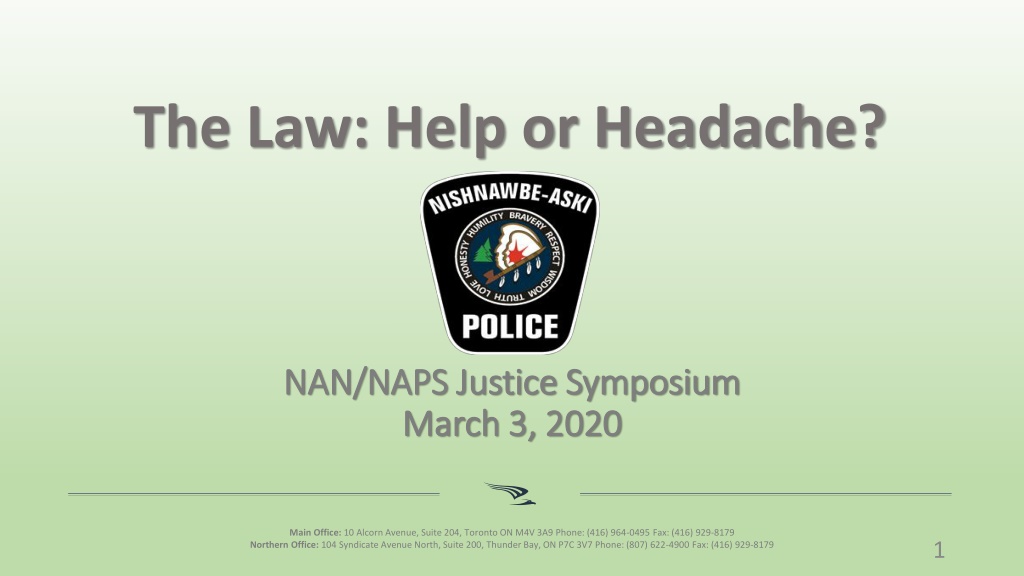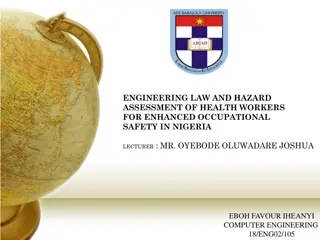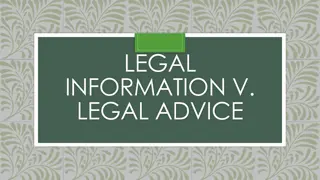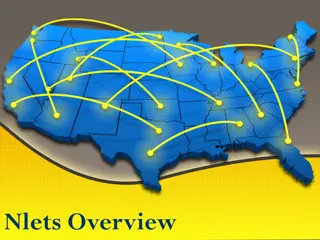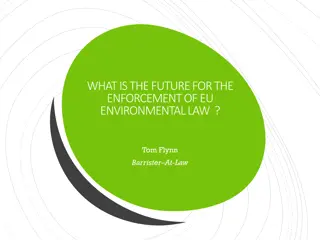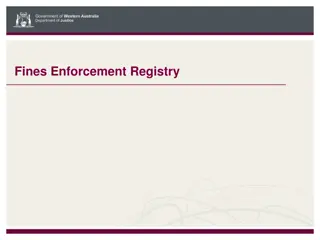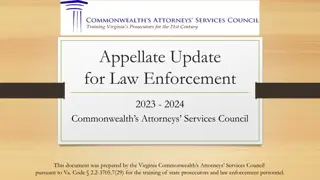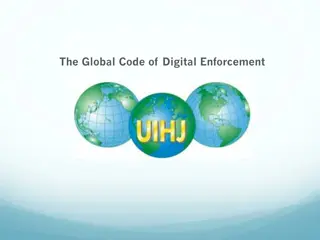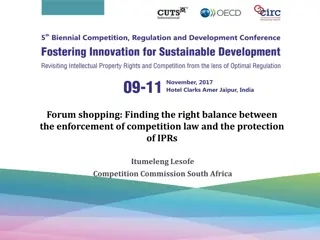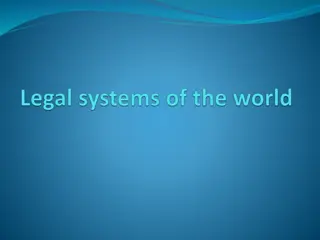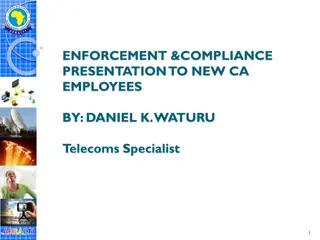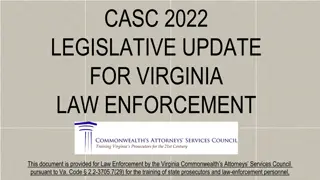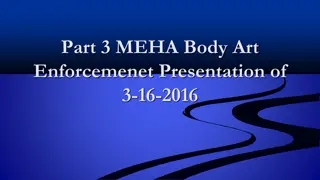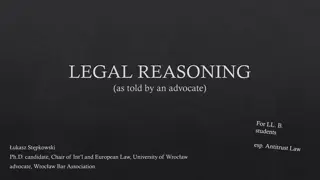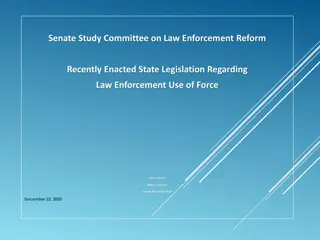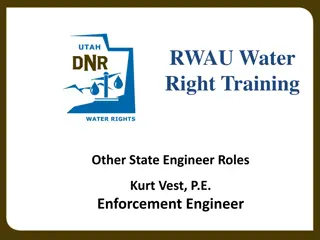Exploring Legal Considerations in Law Enforcement Scenarios
Delve into the complexities of law enforcement scenarios involving removal and search/seizure in First Nations communities. Explore the legal considerations, by-laws, and protocols guiding these situations, offering insights into navigating these sensitive matters effectively.
Uploaded on Sep 24, 2024 | 0 Views
Download Presentation

Please find below an Image/Link to download the presentation.
The content on the website is provided AS IS for your information and personal use only. It may not be sold, licensed, or shared on other websites without obtaining consent from the author. Download presentation by click this link. If you encounter any issues during the download, it is possible that the publisher has removed the file from their server.
E N D
Presentation Transcript
The Law: Help or Headache? NAN/NAPS Justice Symposium NAN/NAPS Justice Symposium March 3, 2020 March 3, 2020 Main Office: 10 Alcorn Avenue, Suite 204, Toronto ON M4V 3A9 Phone: (416) 964-0495 Fax: (416) 929-8179 Northern Office: 104 Syndicate Avenue North, Suite 200, Thunder Bay, ON P7C 3V7 Phone: (807) 622-4900 Fax: (416) 929-8179 1
OUTLINE OF PRESENTATION OUTLINE OF PRESENTATION INTRODUCTION OF SCENARIOS Scenario 1: Leadership request for enforcement of BCR for Removal Scenario 2: Leadership request for search and seizure SCENARIO 1: LEGAL CONSIDERATIONS re. REMOVAL GENERAL CONSIDERATIONS re. BY-LAWS Template Intoxicant By-law initiative (potential of expanding to other types of by-laws) New provincial policing legislation NAPS ENFORCEMENT COMMUNICATIONS PROTOCOL (PROPOSED) 2
INTRODUCTION OF SCENARIOS INTRODUCTION OF SCENARIOS Goal: contemporary issues relating to safety and law enforcement in your communities through discussion of two familiar scenarios. explore considerations and potential solutions to 3
Scenario 1: BCR for Removal Scenario 1: BCR for Removal A citizen of your First Nation has been living in a common law relationship with a non-member. The couple lives in band housing on your First Nation s reserve. It is an open secret that the common law partner, who is not a citizen of your First Nation, has been bringing drugs into your First Nation for the purposes of trafficking. Chief and Council want this individual out of the community. They pass a Band Council Resolution for their removal. The Chief asks the NAPS officer to assist. What happens next? 4
Scenario 2: Search & Seizure Scenario 2: Search & Seizure Your First Nation has been struggling with an influx of illicit drugs in the community. Chief and Council have been tipped off by a trusted community member about a specific house in which these drugs are being stored and sold from. The Chief passes on this information to their NAPS officer, asking the officer to enter the house and seize all the drugs. What happens next? 5
Legal Considerations re. Removal: By-laws Litigation with a conscience. 6 Main Office: 10 Alcorn Avenue, Suite 204, Toronto ON M4V 3A9 Phone: (416) 964-0495 Fax: (416) 929-8179 Northern Office: 104 Syndicate Avenue North, Suite 200, Thunder Bay, ON P7C 3V7 Phone: (807) 622-4900 Fax: (416) 929-8179
Removal: Overview Removal: Overview Canadian Case Law: BCR must be incorporated into a by-law Removal Template: Tobique Nation Trespass Act (2017) Indian Act, s. 81(1) and Removal Key Features of Removal Indian Act, s. 85(1)and Eviction Model By-laws More Canadian Case Law: Canadian Court Decisions on Removal 7
Canadian Case Law: Canadian Case Law: BCR must be incorporated into a by BCR must be incorporated into a by- -law law Key Facts: Norway House Band Council passed a BCR declaring that any community member caught using drugs or alcohol would be (a) evicted from their residence and (b) subject to removal from the Community. Subsequently, Tron Gamblin, a Member, was charged with possession of a controlled substance (marijuana). Council ordered Gamblin to (a) vacate his home and (b) leave the reserve. Gamblin challenged the decision in Court. The Court ruled that the Removal was illegal. In order to removal by BCR, the Council must adopt a by-law first. Important Note: the Court also ruled that the eviction was legal, since Gamblin violated the private tenancy contract that prohibited illegal drugs. 8 *Gamblin v. Norway House Cree Nation (Band Council), [2000] F.C.J. No. 2132
Tobique Tobique First Nation (2017): First Nation (2017): Model Removal and Trespass Bylaw Model Removal and Trespass Bylaw Although the Indian Act does not contain explicit removal powers, many Councils including Tobique First Nation have successfully adopted removal powers by passing residency/trespass by-laws pursuant to s. 81(1) of the Indian Act. In practice, when a Nation adopts a Trespass/Residency By-law, the by-law s first or second clause should expressly state that its powers derive from s. 81(1), subsections (c), (p), (p.1), (q), (r). See next slide for text of s. 81(1) The Tobique Trespass Act grants Council the power to remove Members for criminal conduct or serious bylaw violations, pursuant to s. 81(1) of the Indian Act. Available on-line: http://www.tobiquefirstnation.ca/policies/Trespass%20Act.pdf Key sections include: 9
Indian Act, Indian Act, s. 81(1): Residency/Trespass Bylaws Residency/Trespass Bylaws s. 81(1): 81 (1) The council of a band may make by-laws not inconsistent with this Act or with any regulation made by the Governor in Council or the Minister, for any or all of the following purposes, namely, (c) the observance of law and order; (p) the removal and punishment of persons trespassing on the reserve or frequenting the reserve for prohibited purposes; (p.1) the residence of band members and other persons on the reserve; (q) with respect to any matter arising out of or ancillary to the exercise of powers under this section; and (r) the imposition on summary conviction of a fine not exceeding one thousand dollars or imprisonment for a term not exceeding thirty days, or both, for violation of a by-law made under this section. 10
Key Features of Removal Key Features of Removal When considering the removal of a community member or visitor by BCR, the following guidelines are recommendations for a process: 1)First, it is recommend that a Band Council adopt a Residency/Trespass bylaw. It is recommended that the bylaw explicitly state that its powers derive from: s.35(1) of the Constitution Act: self-determination ; and s. 81(1) of the Indian Act, which gives Nations the power to pass by-laws on residency/trespass. This includes the power of removal and/or eviction. 11
Key Features of Removal (Contd) Key Features of Removal (Cont d) 2) A Trespass/Residency bylaw should set out: A) Grounds for removal; B) Process for removal, including opportunity for a hearing; C) Various punishments/consequences short of removal; D) Opportunity to apply for reinstatement. 12
Key Features of Removal (Contd) Key Features of Removal (Cont d) 3) Once the bylaw is in place, a Council may commence removal proceedings against an individual. At the end of such a process, Council has the power to have the individual removed from the community by BCR. 4) There is a distinction between Removal and Eviction (see slides 14- 16). The court decisions discussed in the following slides suggest that it is easier to evict someone from Band housing than it is to fully remove them from the community. 5) It is likely that an eviction from band housing would have the effect of forcing the individual to leave the community. 13
Eviction and Eviction and Indian Act, Indian Act, s. 85.1(1) s. 85.1(1) Eviction is easier than removal. Canadian courts have consistently held that tenancy agreements between a First Nation and First Nation members are private law contracts. Because of this, a community can include in these contracts any term of its choosing. Cottrell v. Chippewas of Rama Mnjikaning First Nation Band, [2009] F.C.J. No. 369 at 82 In practice, this means that a tenancy agreement can include a term allowing Council to evict the tenant for illegal drug use/intoxication. Section 85.1(1) states that Nations have authority to enact by-laws relating to intoxicants, including prohibiting persons from being intoxicated on the reserve and/or from having intoxicants in their possession on the reserve. 14
Model Removal/Eviction Bylaws Model Removal/Eviction Bylaws Samson Cree First Nation: Residency Bylaw (2012) Gives Council the power to evict and/or remove community members who have been convicted of serious crimes against another person. The stated source for these powers is Indian Act, s. 81(1). http://sp.fng.ca/fngweb/444_residency_by-law_2012.pdf Wahgoshig First Nation: Trespass Bylaw (2016) Bylaw gives Council authority to remove a Non-Member for trespass : Trespass includes the offence of living on-reserve without written authorization; Trespass also includes: violating reserve bylaws, hunting/fishing without a permit, disturbing the peace, criminal acts. Under the bylaw, Council may at any time adopt a BCR removing and/or evicting a Non-Member Resident with written notice. The BCR can order the individual to vacate a specific Premise/Premises, or the reserve as a whole. Grounded in s. 81(1) of the Indian Act 15
An Unsuccessful Removal: Lessons from An Unsuccessful Removal: Lessons from Kamalatisit Kamalatisit v v Sandy Lake First Nation* Sandy Lake First Nation* In 2019, the Canadian Human Rights Tribunal ordered Sandy Lake First Nation to allow a removed resident, Angele Kamalatisit, to return to the reserve. The Tribunal also ordered the Nation to pay her $20,000 for pain and suffering. Key Facts: Sandy Lake First Nation did not have any residency or trespass bylaw. The removal of Ms. Kamalatisit was done by way of BCR by Chief and Council. Ms. Kamalatisit was not a Member of the Nation, but had lived and worked there as a Guest for ten years. 16 *Angele Kamalatisit v Sandy Lake First Nation, 2019 CHRT 20
An Unsuccessful Removal: Lessons from An Unsuccessful Removal: Lessons from Kamalatisit Kamalatisit v v Sandy Lake First Nation* Sandy Lake First Nation* In 2012, the Council removed Kamalatisit, alleging that she was a disruptive presence. The Tribunal found that Kamalatisit was removed as retribution for the political activities of her common-law partner, who was a Member of the Nation, and therefore more difficult to remove. In 2019, the Tribunal found that the Council discriminated against Kamalatisit by denying her occupancy of a residential accommodation based on family/marital status. the prohibited ground of 17
Atikamekw Atikamekw d Opitciwan d Opitciwan c c Weizineau Quebec Court enforces removal order Quebec Court enforces removal order Weizineau*: *: Key Facts: In 2017, the Opitciwan Nation Band Council (Quebec) adopted a Removal/Trespass Bylaw, pursuant to s. 81(1) of the Indian Act. Subsequently, Kelly-Marguerite Weizineau, a resident (unclear if Member or Non-Member) was criminally convicted for trafficking narcotics. The Council then passed a BCR removing Weizineau for five years. She ignored the order and hid in various homes in the community. The Council successfully applied to the Quebec Superior Court to uphold the removal of Weizineau. See next slide re: the Obligation to ensure Support Systems for Removed Persons 18 *Conseil des Atikamekw d Opitciwan c Weizineau, 2018 QCCS 4170
Atikamekw Atikamekw d Opitciwan d Opitciwan c c Weizineau Weizineau cont d cont d The Court also authorized the Council to work with Quebec police to forcibly expel Weizineau if necessary. Note re: Support Systems for Removed Persons: In Weizineau, the Court upheld the removed person s request that her removal be executed in such a way that the defendant is not left alone or without support at the boundaries of the Opitciwan Indian Reserve (para 17). It is therefore good practice for Council to work with the removed person and outside communities to ensure they will have access to support services once they have left the community. 19
CONSIDERATIONS re. BY-LAWS Litigation with a conscience. 20 Main Office: 10 Alcorn Avenue, Suite 204, Toronto ON M4V 3A9 Phone: (416) 964-0495 Fax: (416) 929-8179 Northern Office: 104 Syndicate Avenue North, Suite 200, Thunder Bay, ON P7C 3V7 Phone: (807) 622-4900 Fax: (416) 929-8179
NAPS Template Intoxicant By NAPS Template Intoxicant By- -law Initiative Initiative law Context: Crown and Courts declining to prosecute and try First Nations by-law cases. NAPS working with communities to minimize intoxicant use; has worked with Sandy Lake, Bearskin Lake, Kasabonika re creation & implementation of intoxicant by-laws. S. 85(1) of the Indian Act. Certain procedures must be followed to make the by-law valid and enforceable. 21
NAPS Template Intoxicant By NAPS Template Intoxicant By- -law Initiative (Cont d) Initiative (Cont d) law Key features Provides clarity re. role of NAPS officers, role of by-law enforcement officers, role of community-based committees. Process starts with issuance of a ticket/Certificate of Offence by a NAPS officer for a by-law infraction. The Certificate of Offence offers different options to the person who receives it: a Community Resolution Process option; a fine option; a trial option. Community-based panels/committees enforcement/process. Importance of avoiding conflict of interest. play a role in 22
Challenging a Ticket Challenging a Ticket Within 15 days The options need to be described in the By-law: Consultation with Chief and Council Hearing panel Submitting documentation (e.g. medical) Trial Option 25
Consider Consider Possibility of developing template by-laws for other issues of interest (e.g. eviction) 26
New Policing Legislation: New Policing Legislation: Community Safety and Policing Act, 2019 and Policing Act, 2019 Community Safety Has been passed into law (March 26, 2019) but is not yet in force. Will replace the Police Services Act. Provides a pathway for a First Nation police service and board to be held to the same legislated adequacy standards that all other police services in the Province are held to. 27
Community Safety and Policing Act, 2019 Community Safety and Policing Act, 2019 (Cont d) (Cont d) Introduces specific provisions pertaining to enforcement of First Nations by-laws (not in PSA): Enforcement of First Nations by-laws (except prescribed by-laws, if any) is not a necessary part of the required minimum standard of providing adequate and effective policing (s. 11(2)). A police Board may exceed the required minimum standards, including by providing policing services for enforcement of by-laws (s. 11(3)). A First Nation Board may enter into an agreement with the Minister for funding with respect to enforcement of First Nation by-laws (s. 32(17)). A First Nation band council can enter into an agreement with the Minister to have the Ontario Provincial Police ( OPP ) provide policing on the First Nation reserve or other specified area, and this agreement can specify that enforcement of First Nation by- laws is to be included in the services to be provided by the OPP (ss. 76(1), 76(2)). 28
Community Safety and Policing Act, 2019 Community Safety and Policing Act, 2019 (Cont d) (Cont d) Introduces specific provisions pertaining to enforcement of First Nations by-laws (not in PSA): Enforcement of First Nations by-laws (except prescribed by-laws, if any) is not a necessary part of the required minimum standard of providing adequate and effective policing (s. 11(2)). A police Board may exceed the required minimum standards, including by providing policing services for enforcement of by-laws (s. 11(3)). A First Nation Board may enter into an agreement with the Minister for funding with respect to enforcement of First Nation by-laws (s. 32(17)). A First Nation band council can enter into an agreement with the Minister to have the Ontario Provincial Police ( OPP ) provide policing on the First Nation reserve or other specified area, and this agreement can specify that enforcement of First Nation by- laws is to be included in the services to be provided by the OPP (ss. 76(1), 76(2)). 29
NAPS ENFORCEMENT COMMUNICATIONS PROTOCOL [proposed] Litigation with a conscience. 30 Main Office: 10 Alcorn Avenue, Suite 204, Toronto ON M4V 3A9 Phone: (416) 964-0495 Fax: (416) 929-8179 Northern Office: 104 Syndicate Avenue North, Suite 200, Thunder Bay, ON P7C 3V7 Phone: (807) 622-4900 Fax: (416) 929-8179
Enforcement Communications Protocol Enforcement Communications Protocol 31
Enforcement Communications Protocol Enforcement Communications Protocol Goals: strengthen the relationship between First Nations leadership and NAPS; increase the efficacy of enforcement actions and NAPS responsiveness to community concerns; have improved communication and sharing of information in a manner that: respects police operational independence; does not risk jeopardizing ongoing NAPS operations or officer safety. 32
Enforcement Communications Protocol Enforcement Communications Protocol Key features: For serious/criminal activity. Direct communication between Chief/designate and head of NAPS Intelligence Unit. Chief/designate shares specific concerns with Detective Inspector Brad Duce (807-620-2677), who informs Chief whether NAPS is already aware and already taking enforcement-related steps. Specified report-back time for head of Intelligence Unit to update Chief/designate. 7-10 business days from time of first call. Then as mutually decided on a case-by-case basis. 33
Enforcement Communications Protocol Enforcement Communications Protocol NAPS Intelligence Unit: Mandate: to combat drug trafficking and distribution; firearms investigations; monitoring, arresting and dismantling any gang activity, criminal organization, crime group or its members, responsible for violent criminal activity within the province of Ontario with specific focus on the Northern First Nation Communities Five (5) detectives and a civilian specifically trained in: Drug Enforcement Investigations; Guns & Gangs Investigations; and Criminal Intelligence Analysis. 34
Enforcement Communications Protocol Enforcement Communications Protocol Does not replace or detract from already- existing mechanisms. e.g. Crime Stoppers 1-800-222-TIPS (8477) https://www.canadiancrimestoppers.org/tips 35
Miigwetch! Litigation with a conscience. Main Office: 10 Alcorn Avenue, Suite 204, Toronto ON M4V 3A9 Phone: (416) 964-0495 Fax: (416) 929-8179 Northern Office: 104 Syndicate Avenue North, Suite 200, Thunder Bay, ON P7C 3V7 Phone: (807) 622-4900 Fax: (416) 929-8179 36
